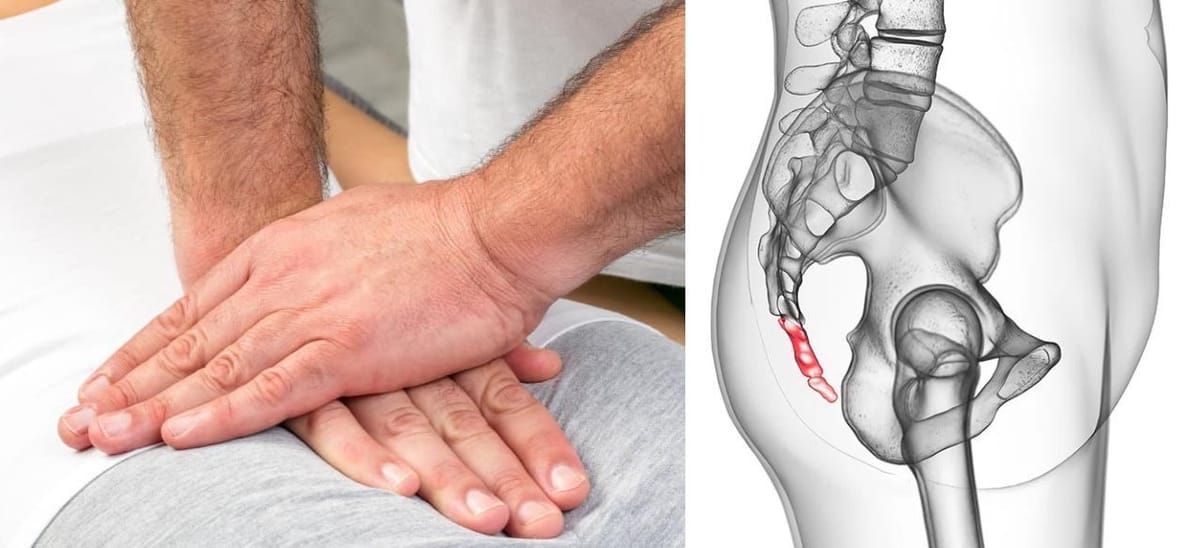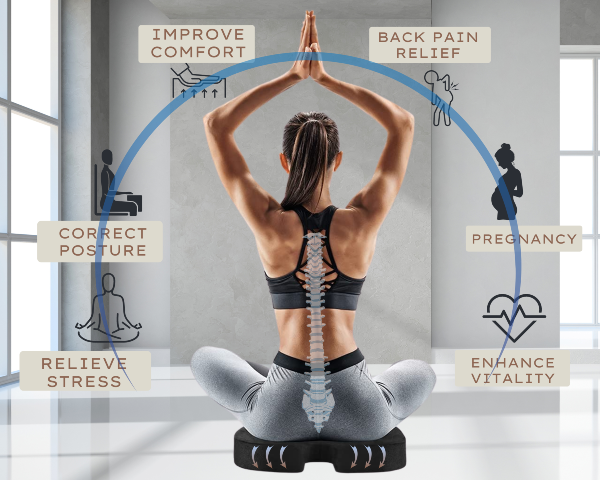Coccyx Pain with Sciatica: Ways To Find Reliefs
Discover effective ways to manage coccyx pain with sciatica, including treatments, exercises, and tips to reduce discomfort and improve mobility.

Coccyx pain, also known as coccydynia, can be a troubling and painful condition that affects the tailbone area. When combined with sciatica, a condition that affects the sciatic nerve running from the lower back down the legs, the discomfort can be even more intense. Understanding the link between coccyx pain and sciatica is essential for proper diagnosis and treatment. In this blog post, we’ll explore the relationship between these two conditions, their symptoms, and effective treatment options to help you find relief.
What is Coccyx Pain?
The coccyx, or tailbone, is the small, triangular bone at the base of the spine. Coccyx pain occurs when there is inflammation, injury, or irritation to this area. Common causes of coccyx pain include:
- Trauma or injury: A fall or accident can damage the tailbone, leading to sharp pain.
- Poor posture: Sitting for long periods on hard surfaces can put pressure on the coccyx, resulting in discomfort.
- Childbirth: Women who have recently given birth may experience coccyx pain due to the pressure placed on the tailbone during delivery.
- Prolonged sitting: Sitting for extended periods, especially on a hard chair, can aggravate the tailbone.
What is Sciatica?
Sciatica refers to pain that radiates along the sciatic nerve, which runs from the lower back down through the hips and buttocks to the legs. It is usually caused by compression or irritation of the sciatic nerve, often due to a herniated disc, bone spurs, or spinal stenosis.
Symptoms of sciatica include:
- Sharp or burning pain: Often felt in the lower back, buttocks, and legs.
- Tingling or numbness: May be experienced in the legs or feet.
- Weakness in the leg: In some cases, sciatica can cause difficulty moving the leg.
The Link Between Coccyx Pain and Sciatica
While coccyx pain and sciatica may seem like separate conditions, they can occur together and even influence each other. The sciatic nerve runs close to the tailbone, and if the nerve becomes irritated or inflamed, it can lead to referred pain in the coccyx area.
Several factors can contribute to both coccyx pain and sciatica:
- Spinal issues: A herniated disc or degenerative disc disease in the lumbar spine can compress the sciatic nerve. This compression can radiate pain to both the lower back and tailbone, causing simultaneous discomfort.
- Poor posture and alignment: Sitting in poor posture or on hard surfaces can put pressure on both the coccyx and sciatic nerve, leading to pain in both areas. Prolonged sitting or slouching can exacerbate both conditions.
- Injury or trauma: A fall or accident that impacts the lower back can cause damage to both the coccyx and sciatic nerve, resulting in pain in both areas.
Symptoms of Coccyx Pain with Sciatica
When coccyx pain and sciatica occur together, the symptoms can overlap, making it harder to differentiate between the two. Here are some common signs that both conditions might be present:
- Pain in the lower back, buttocks, and tailbone: The discomfort may radiate from the lower back down to the legs, mimicking sciatica.
- Worsening pain with sitting: Sitting for long periods or on hard surfaces can aggravate both coccyx pain and sciatica.
- Sharp, stabbing pain or dull ache: The pain may vary in intensity, from sharp, sudden jabs to a constant, dull ache.
- Numbness or tingling: You may experience tingling sensations in your legs or feet due to nerve involvement from sciatica.
- Difficulty moving the lower back or legs: In some cases, both conditions can limit mobility, making it painful to walk or stand for long periods.
Treatment Options for Coccyx Pain with Sciatica
Treating coccyx pain with sciatica often requires addressing both conditions simultaneously. Below are some effective treatment strategies to help alleviate pain and promote healing:
1. Physical Therapy
A physical therapist can help improve posture, strengthen muscles, and reduce pressure on the coccyx and sciatic nerve. Specific exercises may be recommended to address both coccyx pain and sciatica by strengthening the lower back, glutes, and core muscles.
2. Heat and Cold Therapy
Applying a cold compress or ice pack to the affected area can reduce inflammation and numb the pain. After the initial inflammation subsides, switching to heat therapy can help increase blood flow to the affected muscles and promote healing.
3. Pain Relief Medication
Over-the-counter pain relievers such as ibuprofen or acetaminophen can help reduce inflammation and alleviate pain. In more severe cases, a doctor may prescribe muscle relaxants or stronger pain medications.
4. Coccyx Cushion

For those who experience pain while sitting, using a coccyx cushion or pillow with a cut-out in the back can relieve pressure on the tailbone. These cushions are designed to redistribute weight and reduce the strain on the coccyx.
5. Chiropractic Care
Chiropractors can offer spinal adjustments to correct alignment issues that may be contributing to both coccyx pain and sciatica. Gentle manipulations can help alleviate pressure on the sciatic nerve and promote healing.

6. Epidural Steroid Injections
In cases where sciatica pain is severe and unresponsive to other treatments, an epidural steroid injection may be recommended. This procedure involves injecting corticosteroids into the spine to reduce inflammation and alleviate pain.
7. Lifestyle Changes
Improving posture, avoiding prolonged sitting, and incorporating regular movement throughout the day can help prevent the recurrence of both coccyx pain and sciatica. Maintaining a healthy weight and practicing good ergonomics can also reduce strain on the lower back and tailbone.
When to See a Doctor
If you experience persistent or worsening pain in the lower back, tailbone, or legs, it’s important to consult with a healthcare professional. In some cases, sciatica may require more advanced treatments, such as surgery, if conservative methods do not provide relief.
If the pain is severe, sudden, or accompanied by symptoms like weakness, numbness, or difficulty controlling bowel or bladder function, seek immediate medical attention as this could indicate a more serious underlying condition.
Conclusion
Coccyx pain with sciatica can significantly impact your quality of life, but with the right treatment and a proactive approach to managing both conditions, you can find relief and get back to your daily activities. By understanding the connection between these two conditions and taking steps to alleviate pain, you can improve your comfort and prevent future flare-ups.
If you’re struggling with coccyx pain and sciatica, consider consulting with a healthcare provider to develop a comprehensive treatment plan tailored to your needs.
Symptoms of Coccyx Pain With Sciatica
Individuals may experience localized pain in the coccyx, often described as aching or sharp. This can be accompanied by the characteristic radiating pain associated with sciatica.
Contributing Factors
Maintaining poor posture, particularly while sitting, can contribute to both coccyx pain and sciatica. Addressing posture issues becomes crucial in managing and preventing further discomfort.
Management Pain With Coccyx Cushion
Using cushions with a cut-out or wedge design can help alleviate pressure on the coccyx while sitting, reducing both coccyx and sciatic pain. Ergonomic seating and regular breaks from sitting are also beneficial.
Stretching Exercises
Engaging in targeted stretching exercises can relieve tension in the coccyx and alleviate sciatic pain. Movements like pelvic tilts and knee-to-chest stretches promote flexibility and reduce pressure on the nerves.
Heat and Cold Therapy
Applying heat or cold packs to the lower back and coccyx area can provide relief. Heat relaxes muscles, while cold reduces inflammation, offering a combined approach to managing pain.
Medical Consultation
Seeking medical consultation is crucial for a comprehensive understanding of coccyx pain with sciatica. Healthcare professionals can tailor treatment plans, which may include physical therapy, medications, or, in severe cases, surgical interventions.
Key Takeaways!
Frequently Asked Questions
Q: Is coccyx pain commonly associated with sciatica?
A: Yes, coccyx pain can be associated with sciatica due to shared nerve pathways and interconnected musculoskeletal structures. Prolonged sitting, often seen in sciatica, may contribute to coccyx discomfort.
Q: What are the common symptoms of coccyx pain with sciatica?
A: Individuals may experience localized pain in the tailbone region, described as aching or sharp. This is often accompanied by the characteristic radiating pain associated with sciatica.
Q: How does poor posture contribute to both coccyx pain and sciatica?
A: Maintaining poor posture, especially during prolonged sitting, can contribute to both coccyx pain and sciatica. Addressing posture issues becomes crucial in managing and preventing further discomfort.
Q: Can using tailbone cushions help alleviate coccyx pain with sciatica?
A: Yes, cushions with a cut-out or wedge design can reduce pressure on the coccyx while sitting, providing relief for both coccyx and sciatic pain. Ergonomic seating and regular breaks from sitting are also beneficial.
Q: Are there specific stretching exercises that can help with coccyx pain and sciatica?
A: Yes, gentle stretching exercises like pelvic tilts and knee-to-chest stretches can relieve tension in the coccyx and alleviate sciatic pain. These movements promote flexibility and reduce pressure on the nerves.
Q: How can heat and cold therapy be effective for coccyx pain with sciatica?
A: Applying heat or cold packs to the lower back and coccyx area can provide relief. Heat relaxes muscles, while cold reduces inflammation, offering a combined approach to managing pain.
Q: When should I seek medical consultation for coccyx pain with sciatica?
A: If you're experiencing coccyx pain accompanied by sciatica, it's important to seek medical consultation in the following situations:
- Persistent Pain: If the pain lasts longer than a few weeks and doesn't improve with home treatments like rest, ice, or over-the-counter pain relievers, it's time to consult a doctor.
- Severe Pain: If the pain is intense or gets worse over time, especially when sitting or standing, a professional evaluation is necessary to rule out underlying conditions.
- Numbness or Tingling: If you experience numbness, tingling, or weakness in your legs, this could indicate nerve involvement and may require immediate medical attention.
- Difficulty Moving: If the pain affects your ability to walk, stand, or sit comfortably, a healthcare provider can help determine the cause and suggest appropriate treatment.
- Incontinence Issues: Loss of bladder or bowel control is a serious symptom that could indicate a more severe nerve issue, requiring urgent medical consultation.
A healthcare provider will evaluate your symptoms, perform necessary tests, and recommend treatments such as physical therapy, medications, or further investigations to address the root cause of your coccyx pain with sciatica.
